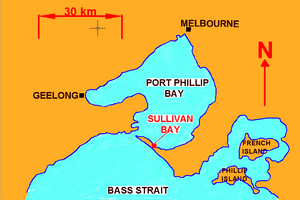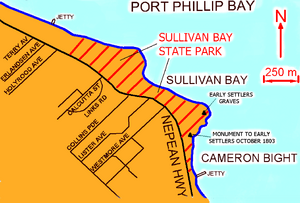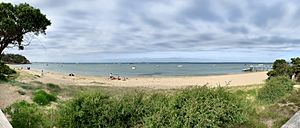Sullivan Bay, Victoria facts for kids
Sullivan Bay is a very important place in the history of Victoria, Australia. It was the first official settlement started by Europeans in this area. It is a small bay located near Sorrento, Victoria, close to the entrance of Port Phillip Bay. This spot is about 60 km (37 mi) south of the big city of Melbourne.
Back in 1802, Governor Philip Gidley King in Sydney thought it was a good idea to start a new settlement at Port Phillip Bay. He wrote to Lord Hobart, who was in charge of the colonies in London. Governor King believed the area would be great for fishing and seal hunting. He was also worried that the French might settle there first and control an important waterway called Bass Strait. Lieutenant John Murray had explored Port Phillip Bay in 1802. He thought the Sorrento area would be a good place to build a new town.
Contents
The Journey to Australia
Lieutenant Governor David Collins was chosen to lead the new settlement. He gathered a large group of over 400 people. This group included 307 convicts, some with their wives and children. There were also 51 soldiers, 17 free settlers (some with families), and 12 government staff members. A clergyman, Reverend Knopwood, also joined them.
The group left England in April 1803. They sailed on two ships: the "Ocean," which carried supplies, and the "Calcutta," which was a convict ship. Their long journey took them across the world. They stopped at Tenerife in the Canary Islands, Rio de Janeiro in Brazil, and Capetown in South Africa. Finally, they arrived at Port Phillip Bay in October 1803. Only 14 people died during the entire trip, which was quite good for such a long voyage back then.
Choosing a Place to Settle
When they arrived, Collins looked for a good place to land. He needed a spot with fresh drinking water and good soil for farming. However, he could not find an ideal location. On 13 October 1803, he decided to land at Sullivan’s Bay. He named the bay after the Under Secretary of the Colonial War Department.
Life at Sullivan Bay
The new settlers faced many challenges at Sullivan Bay. They found a way to get water by digging wooden barrels into the sand. Water would slowly soak into the barrels. However, this water was often salty and not very pleasant to drink. The soil was very sandy, which made it hard to grow crops. There were also very few trees suitable for cutting into timber to build houses.
Moving heavy items was also difficult. The sandy ground meant that wagons would get stuck. Instead, people had to drag their supplies. The entrance to the bay was small, making it tricky for large sailing ships to enter or leave safely. Even the tools they brought from England, like spades and axes, were poorly made and broke easily. They had hoped to catch fresh fish and kangaroos for food, but they were not very successful.
Daily Supplies for Settlers
Life was tough, and supplies were carefully managed. In October 1803, male convicts were given a set of clothes. This included:
Each week, people received a set amount of food. This was called a ration. The weekly food ration included:
- 7 pounds of beef or 4 pounds of pork (which was salted to preserve it)
- 7 pounds of biscuit
- 1 pound of flour
- 6 ounces of sugar
Women received two-thirds of this amount, children received half, and small children under five years old received a quarter.
A convict named Robert Walsh used a small printing press to print orders and instructions for the settlement. During the time the settlement existed, 43 such orders were printed.
Dangers and New Life
Collins warned the convicts not to swim in the water because of the danger from hungry sharks and stingrays. Some convicts tried to escape by walking all the way to Sydney. However, they soon gave up and returned to the settlement.
Not long after they arrived, a settler named John Skilton died on 17 October 1803. But there was also new life. On 25 November 1803, the first child, William James Hobart Thorne, was born to a soldier, Sergeant Thorne, and his wife. Another famous child born to convict parents at Sullivan Bay was John Pascoe Fawkner. He later returned to Victoria and helped start the settlement of Melbourne in 1835.
Why the Settlement Was Abandoned
By November, Collins realized that Sullivan Bay was not a good place for a permanent settlement. He sent the ship "Ocean" to Sydney with a letter to Governor King. In his letter, Collins asked for permission to abandon the settlement. He wanted to move everyone to either Port Dalrymple or the Derwent River in Van Diemen's Land (which is now called Tasmania).
The "Ocean" returned in December with permission to move. Collins quickly began preparing most of the convicts and settlers to leave. He even ordered convicts to work on Sundays to make sure they were ready as soon as possible. On 30 January 1804, the "Ocean" set sail for the Derwent River. Lieutenant William Sladden stayed behind with a small group. The "Ocean" returned later, and on 20 May 1804, the Sullivan Bay settlement was completely abandoned.
What Was Left Behind
After the settlement was abandoned, three people were left behind. Two were convicts who had escaped, and one was a soldier who had run away, named William Buckley. When John Batman came to settle in Victoria 30 years later, he found Buckley living with an Aboriginal tribe.
Today, the only signs of the original settlement at Sullivan Bay are four graves. There are also the remains of a water barrel, which is kept in the Latrobe Library collection.
Images for kids







